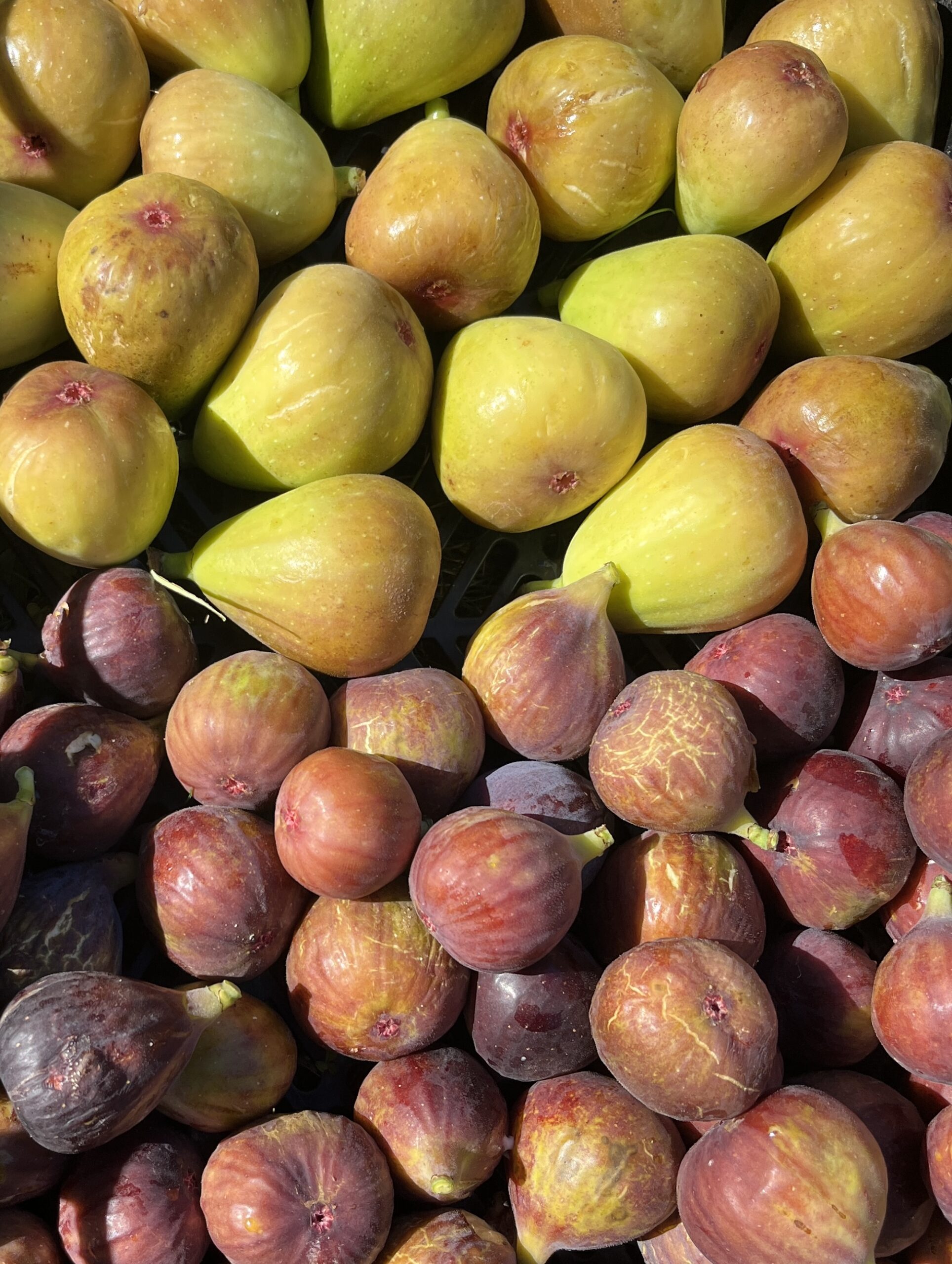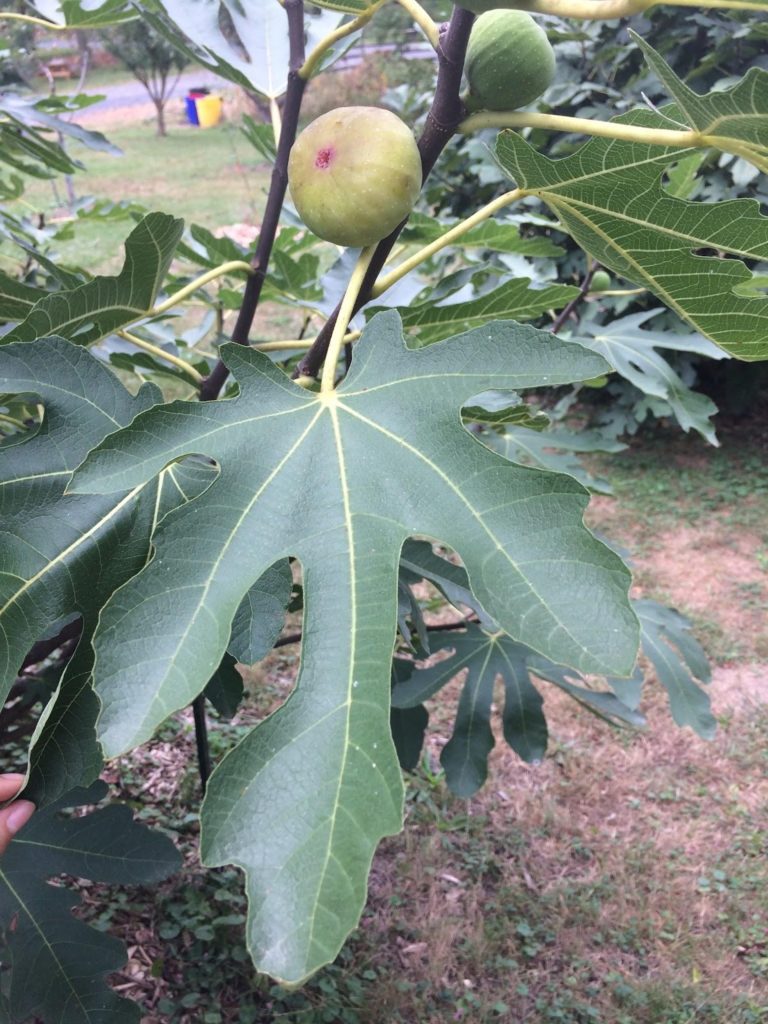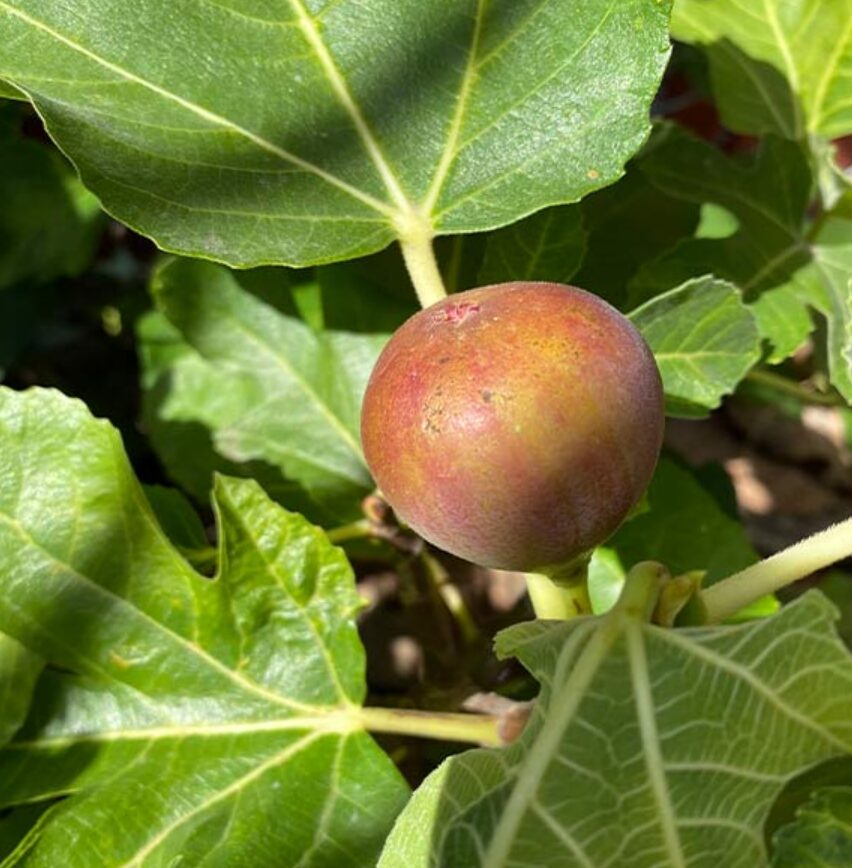The fig was one of the earliest fruit trees to be cultivated, so our history goes way back with these fruits. This might have something to do with the highly abundant and delectable fruit that it offers with little work from our end. Fig trees are some of the easiest fruit trees to tend to, so let’s dig into all the good things figs offer and the specific varieties we have at the POP Learning Orchard.
FIG OVERVIEW
The common fig (Ficus carica) is part of the mulberry family (Moraceae) and Ficus genus, made up of over 750 known species all across the globe. Most Ficus members reside in tropical climates, with some living in temperate climates. The common fig is native to temperate climates in Asia and the Middle East. Figs were spread from the Middle East to its surrounding neighbors by the Romans and Greeks, and eventually moved across Europe and to the Americas. It is now planted worldwide. The common fig is the most cold hardy species of edible fig and the one that is planted in Philadelphia. It prefers hot and dry temperatures, but can tolerate cold weather with some extra love. The heat island effect of Philly actually serves the figs well. It can tolerate most soils, but prefers sandy or well drained soil. It needs full sun to fruit, but will survive in partial shade (although fruit is unlikely to ripen). More detailed information on how to care for figs in Philly climate is linked in POP’s blog and our virtual workshop with Bassem Samaan of Trees of Joy.
The common fig is naturally shrub-like in form with multiple stems, but can be trained to a single trunk with some effort. It has large, deeply lobed deciduous leaves, which exude a white latex when broken. The flowers are not visible and grow inside of the fruit. Turns out the fruit isn’t actually a fruit; it is an inflorescence—a cluster of many flowers contained inside a bulbous stem. One might think the flower is then wind pollinated since the barely visible flower wouldn’t attract any insects, but fig wasps know the lay of the land when it comes to pollinating fig flowers- they crawl inside the fruit to pollinate the flowers to complete their life cycle. However, unlike other fig species, the common fig is self-fertile and doesn’t actually require pollination to produce fruit- good thing because no fig wasps are present in our region! The inflorescence, which we call a “fruit”, appears in late summer and can continue “fruiting” until late fall. Some varieties produce only the main crop in late summer/fall, while others bear an additional early crop in mid summer on second year wood (called the Breba crop) but only after a mild winter or with good winter protection. The “fruit” are borne singly or in pairs in the leaf axils.

USES OF THE FIG
Figs are prominent in Middle Eastern and Mediterranean cuisines. Figs are now grown commercially in Italy, Turkey, Algeria, Greece, Portugal, Spain, and the United States (California, to be specific) and are mostly distributed in dried form. Though they are grown in the Mid-Atlantic region, they are not grown on a large commercial scale. Figs can be eaten fresh, dried, in pastries, or processed into a jam or syrup. Underripe figs can be preserved as pickles or in syrup.

Source: Wikimedia Commons
CULTURAL SIGNIFICANCE OF THE FIG
The fig has been an important plant across many different cultures for a lot of human history. Archaeologists say that the common fig may have been one of the first plants domesticated by humans. The fig carries powerful meaning and is a revered icon across many different cultures across the globe. It makes an appearance in many different religions, representing fertility, abundance, and knowledge. A prominent moment for the fig in Christianity is when Adam and Eve used fig leaves to conceal themselves in the Garden of Eden, which inspired many Western sculptors and painters to incorporate fig leaves into their art. Ficus religiosa, an Asian fig species, is considered sacred by Hindus, Jains, and Buddhists. In Buddhist scripture, the Buddha reached enlightenment by sitting under the sacred fig. Islam also considers some figs to be holy. Fig tree symbolism is seen in art, literature, and folklore throughout history.

Source: Wikimedia Commons
VARIETIES
Figs of one of POP’s favorite fruits to grow and many varieties can be found in most partner orchard sites, due to their ease in maintenance nature and low pest and disease pressure. The POP Learning Orchard has 6 varieties growing there currently, with many other varieties potted up in the nursery. Selected varieties were chosen to have a wide range of fruit, demonstrate the best adapted fig varieties for Philadelphia, and to be able to propagate new trees. Below is a list of all the varieties currently growing at POP’s Learning Orchard. An interactive map of all the fig varieties growing at the Learning Orchard can be found on our Tree Finder Map.
Varieties
- Sal’s Corleone
- Chicago Hardy
- Ronde de Bordeaux
- Larchwood
- Florea
- Bethlehem Black
SAL’S CORLEONE
This fig variety is originally from Sicily. It eventually ended up in the hands of someone named Sal in Huntington Station, Long Island.
This variety produces a medium-sized reddish fig. The inside color ranges from an amber to a light pink. It is very juicy with few seeds. In a mild winter or with good winter protection, Sal’s Corleone produces a good ‘Breba’ crop in summer, before the main crop.

CHICAGO HARDY
This variety is believed to originally hail from Sicily, despite the name, which originated with its survival and production in the cold winters of Chicago. Like most figs, it made its way into North America from all kinds of immigrant backgrounds.
This tree is known for its productivity in cold climates. The fruit are small to medium-sized with distinct necks and are burgundy with a reddish inside and are of good flavor. It is highly productive and ripens early in the season. Once it is established, even if it is winter killed to the ground, it can still produce fruit that year due to how fast the fruit grows and ripens on the tree! This differs from most figs, which will grow back but will likely not have a fruit harvest after a harsh winter.

RONDE DE BORDEAUX
The Ronde de Bordeaux originates from the Bordeaux region of France.
The fruit is medium-sized and purple/black on the outside and pink on the inside. The fruit ripens very early and has excellent berry-like flavor. Even after splitting, which it frequently can do due to its round shape, it has great spoilage resistance, which results in it becoming semi-dried. In this state, it tastes like candy, almost just as good as when it is perfectly ripe. The tree itself is generally smaller than other figs.

LARCHWOOD
The origin of Larchwood is unknown. It was given its name when POP co-director Phil Forsyth propagated this variety from an old tree on Larchwood Avenue in West Philadelphia.
The fruit is medium to large and comes in a tear drop shape. They are green when ripe with a juicy red interior. This variety produces one of the best tasting figs, according to POP’s partners across the city. The fruit has a juicy, sweet flavor. During a harsh winter, it requires extra protection in order to produce fruit that same year.

FLOREA
Also called Michurinska-10, this variety originated in Bulgaria and has very deeply lobed leaves. Florea is very cold hardy, very productive, and ripens early, making it a great for regions with cold and short summers. The fruit is burgundy that fades into a yellow near the stem with a light pink inside. The fruit has a small eye so seems to resist souring. The fruit is quite tasty, but Florea is best known for its toughness, early ripening, and long fruiting period.

BETHLEHEM BLACK
This variety likely comes from Greece. It was named for the Lehigh Valley town in Pennsylvania where it was discovered by fig collector Bassem Samaan of Treesofjoy.com.
The tree has leaves with three lobes. The fruit is small-medium sized and dark purple in color. It has a strong strawberry flavor. The tree is very cold hardy, early ripening, and highly productive. It is similar in flavor, production and cold tolerance to Chicago Hardy.

SOURCES
POP fig workshop with Bassem Samaan of Trees of Joy
Figs in Paradise: A Report from South Philly
Figs Believed to Be First Cultivated Fruit
DISCLAIMER
The information presented on this website is for informational, reference, and educational purposes only and should not be interpreted as a substitute for diagnosis and treatment by a health care professional. Always consult a healthcare professional or medical doctor when suffering from any health ailment, disease, illness, or injury, or before attempting any traditional or folk remedies. Keep all plants away from children. As with any natural product, they can be toxic if misused.
This POP Blog was written by Orchard Coordinator Simone Shemshedini with help from Co-Executive Director Phil Forsyth.
SUPPORT US! If you found this entry useful, informative, or inspiring, please consider a donation of any size to help POP in planting and supporting community orchards in Philadelphia: phillyorchards.org/donate